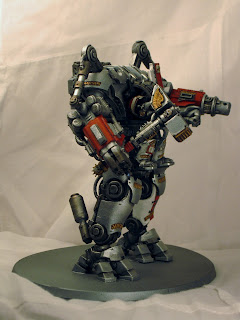Last week, I got griped at pretty good for saying that Orks sucked after playing a sub-optimal list in a game where I had a handy advantage after only 2 turns. You can see that battle report here. From there, I got a mention and some interesting ideas from AbusePuppy over at 3++ about what makes an army "good". Of course, AP looks at things from a fairly competitive, tactical perspective, which guided the article.
From there I decided to put out a poll to see what prompted people to pick an army. The options available were competitive ability, multiple viable builds, fluff/character of the army, and models. I tried to arrange the options in a vague spectrum from competitiveness to fluffiness. Competitive ability and multiple viable builds fall more towards competitive quality while fluff/character of army and models follow more solidly in the fluffy camp. The results were interesting, but what do they mean?
| For all of you youtube fans |
Next, 5 respondents chose multiple viable builds. While I am somewhat competitive, I like this option best as I don't like to feel stagnated in any army. Armies like Tau or Necrons would not rate high on my list of armies simply because there isn't much choice on how I build my armies. Armies like Eldar and Marines provide whole hosts of models and options that create multiple builds of which many are viable. I like this. Anyway, tangent aside, 20% of the field* was taken from this selection.
Next, fluff/character of army had 9 respondents accounting for 37% of the field*. I think this is a huge one as the average gamer with zero experience in the game chooses the army that strikes a chord with them. I began playing with Black Templars because I loved the knightly feel to the army.
Finally, 8 respondents said that they chose an army based on the models. That was 33% of the field*. I find this one interesting because I can see how a player might be swayed to play an army based on the look of its models, but I think this a dangerous slope to be on. DE are a great example of this. Mandrakes, incubi, talos pain engines, etc. look amazing, but in a hobby where everything costs so blasted much, you begin to see a trend of models getting relegated to the shelf because, while looking amazing, they don't play well at all. This can be really frustrating as a gamer.
*Oddly enough, Google calculated the entire survey to only 98%, not 100%. That seems odd, but oh well.
So, as I look at this poll I begin to see trends. Here are the few things I can determine. Note that I am generalizing across the hobby community based on 24 votes, so the results are hardly representative, but I will treat them like they are.
1) The majority of players choose armies based on their fluff or how they look. An army's flavor really does determine if a first time gamer (and many long time gamers) will play it.
2) Since the fewest number of votes went to competitive ability, it is my belief that the 40k community at large isn't as competitive as some would think. Granted, this is a wargame where the point is to beat your opponent, so I think all gamers have some spark of competitiveness in them, though this will vary greatly. I just don't think the community, in majority, is tournament competitive. This also means that the blogosphere may not adequately portray the 40k community correctly. Or at least not representatively. What I mean by this is while a large number of outspoken bloggers speak about competitive gaming, their audiences are not composed in large part of competitive gamers, but rather regular joes who want to learn a bit more about the hobby and tactics. I see this backed up when I play a wide array of players on Vassal as none of them play using optimized list or netlists.
3) This makes me wonder what effect blogging is having on the overall community or if the majority of 40k players even look at blogs. Surely some of the better blogs out there are putting up some big pageview stats so I assume that there is a large segment of the community reading blogs. Are players really learning something and taking away big gains? Or, do they simply read for enjoyment?
This was definitely an interesting poll. I am now interested in seeing what elements of an army's fluff or character attract players to those armies. Is it a personality thing or are there key elements of an army's composition that draw players to them?
I will have to pursue this further soon. Thanks for reading.
















